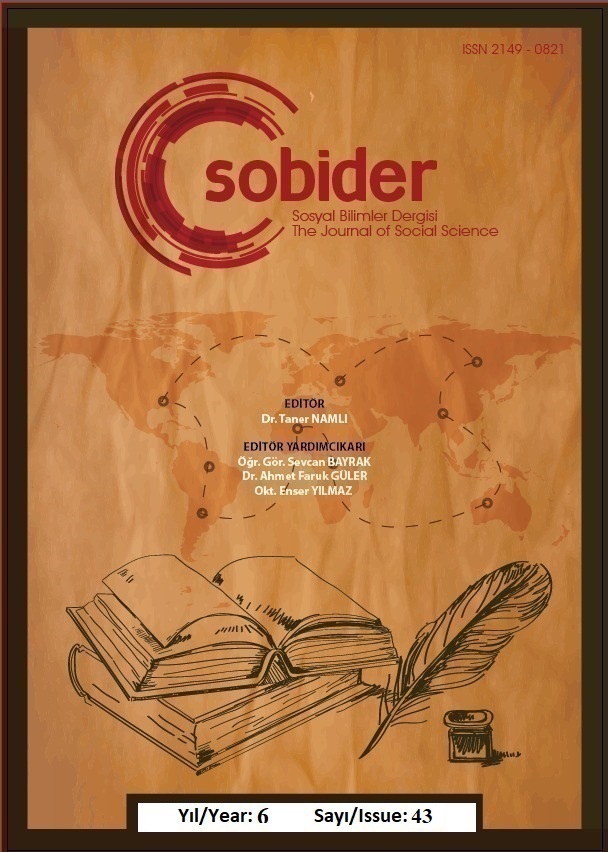Author :
Abstract
Sanat eserleri, sadece sanatkârlarının değil aynı zamanda içinde oluştukları toplumların zevk ve karakterlerini de yansıtırlar. Bir bakıma sanat disiplinlerindeki yeni ekoller, geçmiş birikimlerin süreçlerinde gelişim ve değişim gösterirler. Bu bağlamda yeni ekollerin hazırlayıcısı olan ve üslûplar arasında köprü vazifesi gören temel devreleri çok iyi tahlil etmek gerekmektedir. Döneminin şaheseri olarak da tanınan Ayasofya şadırvanı celî talik kitabeleri bakımından da son derece önemlidir. Şair Emin in on altı beyit halinde yazılmış tarih manzumesi olan kitâbeler, Türk Ta‘lîk hattında döneminin özelliklerini sergiler. konumuzla ilişkili olması bakımından incelenmiştir. Bu aşamada tarafımızdan fotoğraflanarak aynı zamanda estampajları da alınmıştır. Nasıl ki plastik sanatlar disiplinindeki diğer sanat kollarında ekol sahibi sanatkârların çizgi ve desen kalıpları son derece önem arz ediyorsa hat sanatındaki disiplinler için de aynı durum sözkonusudur. Harf karakterlerinin gerçeğine çok yakın görüntülerinin elde edildiği estampaj kalıplarında harflerin yapılarındaki özellikler, alanında birer kaynak teşkil etme özelliğindedir. Hattatlara özel olan harf biçimlerine, klasik ifadesiyle, şive-i kitabet denilmektedir. Sanatçıya özgün yazı karakterleri, bu estampaj kalıplarında kolayca görülebilmektedir.
Keywords
Abstract
Works of art reflect not only the artists but also the aesthetic values of the societies in which they are formed. That is why arts reach maturity at the end of a process of development and new schools are formed. In other words, art disciplines change and develop with new schools, past acquisitions and accumulations. In this context, it is necessary to know and analyze the past styles which have an effect on the emergence of new schools. The Hagia Sophia fountain was accepted as a masterpiece in its field. Hagia Sophia not only in terms of architectural features, but also in terms of showing the letter features of his inscriptions are very valuable. The text of the inscription, which consists of sixteen couplets, is written in verse form by the poet Emin. These inscriptions were photographed and also their estampages were transferred on paper by us. The letters' characters of these inscriptions were examined, in terms of Turkısh Celî Ta‘lîk. The letters' characters of these inscriptions were examined, in terms of Turkısh Celî Ta ‘lîk. As in other art disciplines, in islamic calligraphy, knowing and imitating the methods of famous artists is very important in the education of calligraphers. In these estampages, the characters of the calligraphy are easily seen. This study introduces the inscriptions and their estampages written in the kind of Turkish Celî Ta‘lîk that have been placed on the eaves of the dome of the Hagia Sophia Fountain.
Keywords
- Alparslan, Ali (1977), “Mimari Yapıların Yazı Sanatı Bakımından Önemi”, Boğaziçi Üniversitesi Dergisi, 5, İstanbul
- Erbaş(Maktal), Aynur (1995), Mektûbî İbrahim Efendi’nin Rûhu’t-ta‘lîk Adlı Eserinin Hat Sanatı Bakımından Analizi, Yayınlanmamış Sanatta Yeterlik Tezi, Dokuz Eylül Üniversitesi, Sosyal Bilimler Enstitüsü, Geleneksel Türk Sanatları Anabilim Dalı, 136 sayfa.
- Eyice, Semavi(1991), “Ayasofya Şadırvanı”, T.D.V. İslâm Ansiklopedisi, İstanbul, C:38, s.217.
- Kılcı, Ali (2010), “Şadırvan”, T.D.V. İslâm Ansiklopedisi, İstanbul, C: 38, s. 219-221. LEVEND, Agah Sırrı(1973), Türk Edebiyâtı Tarihine Giriş, Ankara, Türk Tarih Kurumu Y.
- Maktal(Erbaş), Aynur (1999), “Hüsn-i Hat Tasarımlarında Yazı Mekan İlişkisi”, 2000’li Yıllarda Türkiye’de Geleneksel Türk El Sanatlarının Sanatsal, Tasarımsal ve Ekonomik Boyutu Sempozyumu Bildirileri ( Kasım 25-27, 1998), Ankara, s. 197-201.
- Maktal(Erbaş), Aynur (2008), “Rûhû’t-ta‘lîk, T.D.V. İslam Ansiklopedisi, C: 35, s.215-216.
- Serin, Muhittin(1999), Hat Sanatı ve meşhur Hattatlar, İstanbul, Kubbealtı Neşriyatı 68.
- Tansuğ, Sezer (1965), “18. Yüzyılda İstanbul Çeşmeleri ve Ayasofya Şadırvanı”, Vakıflar Dergisi, VI, s. 93-110.
- Tüfekçioğlu, Abdülhamit (2001), Erken Dönem Osmanlı Mimarîsinde Yazı, Ankara Kültür Bakanlığı Yayınları 2642.
- Yardım, Ali (2002), Alanya Kitâbeleri, İstanbul, İstanbul Fetih Cemiyeti Yayınları.
- Yetkin, Suut Kemal(1974),İslâm Ülkelerinde Sanat, İstanbul.





